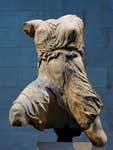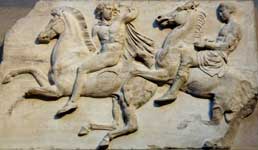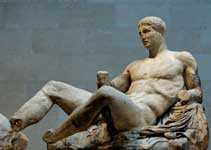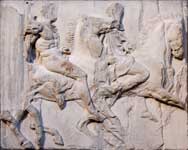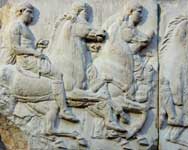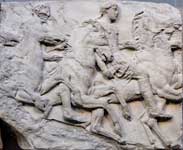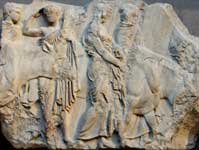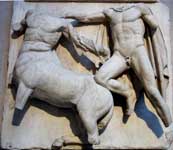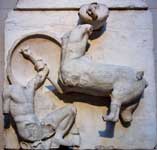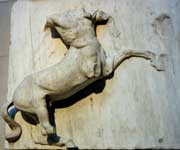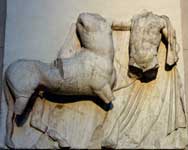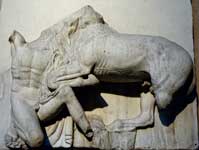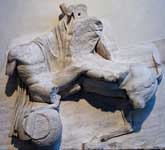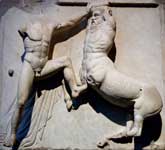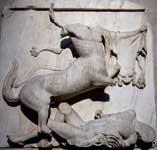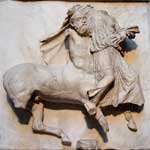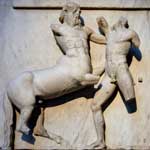.
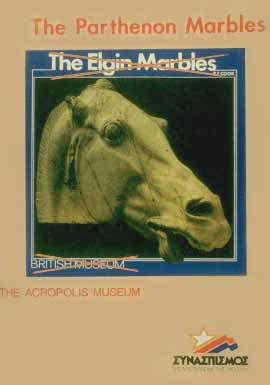
The Elgin Marbles are Parthenon Marbles
The Elgin Marbles is the popular term for the Parthenon Marbles, a large collection of marble sculptures brought to Britain between 1801 and 1805 by Thomas Bruce, 7th Earl of Elgin, the official British resident in Ottoman Athens, who had ordered them removed from the Parthenon. Since 1939 they have been housed in the purpose-built Duveen Gallery of the British Museum, London.
The Elgin Marbles include some of the statuary from the pediments, the Metope panels depicting battles between the Lapiths and the Centaurs, as well as the Parthenon Frieze which decorated the horizontal course set above the interior architrave of the temple. As such, they represent more than half of what now remains of the surviving sculptural decoration of the Parthenon: 247 feet from the original 524 feet of frieze; 15 out of 92 metopes; 17 partial figures from the pediments, as well as other pieces of architecture. Elgin's acquisitions also included objects from other buildings on the Athenian Acropolis: the Erechtheum, reduced to ruin during the Greek War of Independence (1821-33); the Propylaea, and the Temple of Athena Nike. Lord Elgin took half of the marbles from the Parthenon and wax casts were produced from the remaining ones. It is important to note that the wax casts are in far better condition than the originals in Athens, while the marbles in the British Museum have fared much better than their counterparts that were left atop the Parthenon.
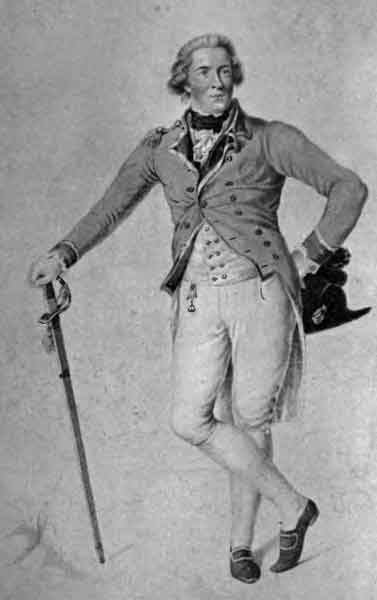
Lord Elgin (c. 1795)
Lord Elgin was neither the first, nor the last, to disperse elements of the marbles from their original location. The remainder of the surviving sculptures that are not in museums or storerooms in Athens are held in museums in various locations across Europe. The British Museum also holds additional fragments from the Parthenon sculptures acquired from collections that have no connection with Lord Elgin.
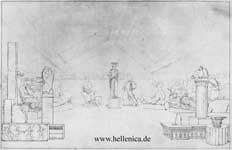
Elgin Marbles, Lord Elgin Museum , Park Lane
When the marbles were shipped to Britain, there was criticism of Elgin (who had spent a fortune on the project) but also much admiration of the sculptures. Lord Byron strongly objected to their removal from Greece:
Dull is the eye that will not weep to see
Thy walls defaced, thy mouldering shrines removed
By British hands, which it had best behoved
To guard those relics ne’er to be restored.
—"Childe Harold's Pilgrimmage"
Byron was not the only Englishman to protest the pillage at the time:
"The Honourable Lord has taken advantage of the most unjustifiable means and has committed the most flagrant pillages. It was, it seems, fatal that a representative of our country loot those objects that the Turks and other barbarians had considered sacred,"
said Sir John Newport, a contemporary MP. Thomas Hughes, an eye witness, later wrote:
"The abduction of small parts of the Parthenon, of a value relatively small but which previously contributed to the solidity of the building, left that glorious edifice exposed to premature ruin and degradation. The abduction dislodged from their original positions, wherefrom they precisely drew their interest and beauty, many pieces which are altogether unnecessary to the country that now owns them."
John Keats was one of those who saw them privately exhibited in London, hence his two sonnets about the marbles. Some scholars, notably Richard Payne Knight, insisted that the marbles dated from the period of the Roman Empire, but most accepted that they were authentic works from the studio of Phidias, the most famous ancient Greek sculptor. They were eventually purchased by Parliament for the nation in 1816, for £35,000 a much lower sum than the £75,000 Lord Elgin had been asking. The marbles were subsequently deposited in the British Museum, where they were displayed in the Elgin Saloon (constructed in 1832), remaining there until the Duveen Gallery was completed in 1939.
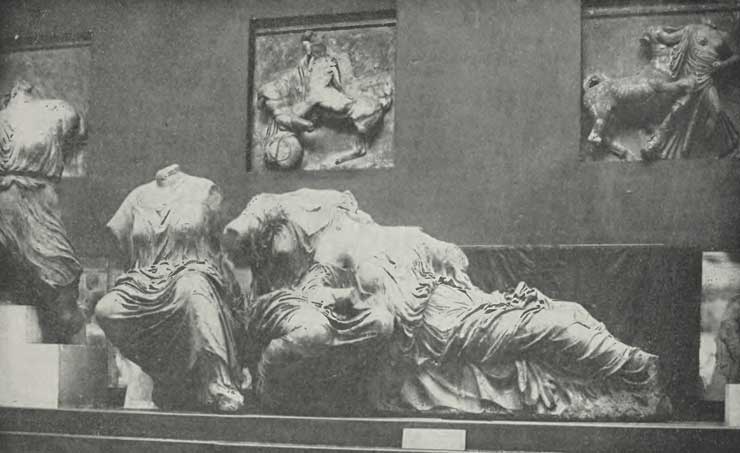
Elgin Marbles in the British Museum, East Pediment

Elgin Marbles, compared to the old image parts of hands included (Source)
There has been considerable debate over what should now be done with the marbles. Although Elgin's motives in removing them from a hazardous environment may have been of the best, many people, especially the Greek government, feel that they should be returned to Athens and displayed in a museum on the Acropolis site. No one is at present recommending that they be returned to their places on the Parthenon, exposed to the elements. However, no consensus has been reached, and the British Museum strongly defends its right to own and display the marbles.
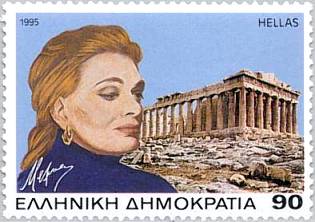
Melina Mercouri supported he return of the Parthenon Marbles
At present, approximately two-thirds of the frieze is in London and a third remains in Athens. Considerable debate surrounds the meaning of the frieze but most agree that it depicts the Panathenaic procession that paraded through Athens every four years. The procession on the frieze culminates at the East end of the Parthenon in a depiction of the Greek gods who are seated mainly on stools, either side of temple servants in their midst. This section of the frieze is currently under-appreciated as it is split between London and Athens, a doorway in the British Museum masking the absence of the relevant section of Frieze. An almost complete copy of this section of the Frieze is displayed and open to the public at Hammerwood Park near East Grinstead in Sussex.
The Greek Government are in the process of building the New Acropolis Museum, designed by the Swiss / American architect Bernard Tschumi. The new museum is designed to hold the Parthenon sculptures arranged in the same way as they would have been on the Parthenon. It is intended to leave the spaces for the Elgin Marbles empty, rather than using casts in these positions, as a reminder to visitors of the fact that parts are held in other museums. The New Acropolis Museum is due to be completed in late 2006.

The Elgin Marbles belong to the people who created them
William Martin Leake. Sailed with the original ship engaged to convey the Elgin marbles from Athens to England.
That which Grecian art created,
Let the Frank, with joy elated,
Bear to Seine's triumphant strand,
And in his museums glorious
Show the trophies all-victorious
To his wondering fatherland.
They to him are silent ever,
Into life's fresh circle never
From their pedestals come down.
He alone e'er holds the Muses
Through whose breast their power diffuses,—
To the Vandal they're but stone!
Friedrich Schiller, THE ANTIQUES AT PARIS.
|
|
|
|
|
|
|
|
|
|
|
|
|
|
||
|
|
|
|
|
|
|
|
|
|
|
|
|
|
|
|
|
|
|
|
|
|
Further reading
Christopher Hitchens, The Elgin Marbles: Should they be returned to Greece? (with essays by Robert Browning and Graham Binns) (Verso, March 1998)
Christopher Hitchens, Imperial Spoils: The Curious Case of the Elgin Marbles (Hill & Wang, 1988)
Links
- A guide to the Marbles
- British Committee for the restitution of the Parthenon Marbles' site
- The British Museum Parthenon pages
- A site by Ian Swindale
- A collection of all current news articles relevant to the marbles
- Gillen Wood, "The strange case of Lord Elgin's nose": the cultural context of the early 19th century debate over the marbles, the politics and the esthetics, imperialism and hellenism
- Information about arguments for the marbles to be returned to Greece
| Ancient Greece
Science, Technology , Medicine , Warfare, , Biographies , Life , Cities/Places/Maps , Arts , Literature , Philosophy ,Olympics, Mythology , History , Images Medieval Greece / Byzantine Empire Science, Technology, Arts, , Warfare , Literature, Biographies, Icons, History Modern Greece Cities, Islands, Regions, Fauna/Flora ,Biographies , History , Warfare, Science/Technology, Literature, Music , Arts , Film/Actors , Sport , Fashion --- |
Retrieved from "http://en.wikipedia.org/"
All text is available under the terms of the GNU Free Documentation License

